Students can Download Tamil Nadu 11th Economics Model Question Paper 5 English Medium Pdf, Tamil Nadu 11th Economics Model Question Papers helps you to revise the complete Tamilnadu State Board New Syllabus and score more marks in your examinations.
TN State Board 11th Economics Model Question Paper 5 English Medium
Instructions:
- The question paper comprises of four parts.
- You are to attempt all the parts. An internal choice of questions is provided wherever applicable.
- questions of Part I, II. III and IV are to be attempted separately
- Question numbers 1 to 20 in Part I are objective type questions of one -mark each. These are to be answered by choosing the most suitable answer from the given four alternatives and writing the option code and the corresponding answer
- Question numbers 21 to 30 in Part II are two-marks questions. These are to be answered in about one or two sentences.
- Question numbers 31 to 40 in Parr III are three-marks questions, These are to be answered in about three to five short sentences.
- Question numbers 41 to 47 in Part IV are five-marks questions. These are to be answered) in detail. Draw diagrams wherever necessary.
Time: 3 Hours
Maximum Marks: 90
Part – I
Choose the correct answer. Answer all the questions: [20 × 1 = 20]
Question 1.
Cost functions are derived from ………………. function.
(a) production
(b) investment
(c) demand
(d) consumption
Answer:
(a) production
![]()
Question 2.
Producer’s equilibrium is achieved at the point where: …………….
(a) Marginal Rate of Technical Substitution [MRTS] is greater than the price ratio
(b) MRTS is lesser than the price ratio
(c) MRTS and price ratio are equal to each other
(d) The slopes of isoquant and isocost lines are different
Answer:
(c) MRTS and price ratio are equal to each other
Question 3.
Utility means
(a) Equilibrium point at which demand and supply are equal
(b) Want-satisfying capacity of goods and services
(c) Total value of commodity
(d) Desire for goods and services
Answer:
(b) Want-satisfying capacity of goods and services
Question 4.
Which one of the following is a developed nation?
(a) Mexico
(b) Ghana
(c) France
(d) Srilanka
Answer:
(c) France
![]()
Question 5.
The weakness of Indian Economy is
(a) Economic disparities
(b) Mixed economy
(c) Urbanisation
(d) Adequate employment opportunities
Answer:
(a) Economic disparities
Question 6.
Explicit cost plus implicit cost denote cost.
(a) social
(b) economic
(c) money
(d) fixed
Answer:
(b) economic
Question 7.
“Economics is a science” The basis of this statement is
(a) Relation between cause and effect
(b) Use of deductive method and inductive method for the formations of laws
(c) Experiments
(d) All of the above
Answer:
(d) All of the above
Question 8.
The world fastest growing economy is
(a) USA
(b) UK
(c) Germany
(d) India
Answer:
(d) India
![]()
Question 9.
Find the odd one out:
(a) “An inquiry into the nature and the causes of the wealth of nations”
(b) “ Principles of Economics”
(cj “Nature of significance of Economic Science”
(d) “ Ceteris paribus”
Answer:
(b) “ Principles of Economics”
Question 10.
Choice is always constrained or limited by the ………………. of our resources.
(a) scarcity
(b) supply
(c) demand
(d) abundance
Answer:
(a) scarcity
Question 11.
Identify the year of launch of MUDRA Bank.
(a) 1995
(b) 2000
(c) 2010
(d) 2015
Answer:
(d) 2015
Question 12.
The highest rate of tax under GST is [as on July 1st 2017]
(a) 18%
(b) 24%
(c) 28%
(d) 32%
Answer:
(c) 28%
![]()
Question 13.
The concept of meeting unexpected expenditure according to Keynes is
(a) Transaction motive
(b) Precautionary motive
(c) Speculative motive
(d) Personal motive
Answer:
(b) Precautionary motive
Question 14.
The cost that remains constant at all levels of output is…………….cost.
(a) fixed
(b) variable
(c) real
(d) social
Answer:
(a) fixed
Question 15.
Revenue received from the sale of additional unit is termed as revenue.
(a) profit
(b) average
(c) marginal
(d) total
Answer:
(c) marginal
Question 16.
Function with single independent variable is ………………….
(a) Multivariate function
(b) Bivariate function
(c) Univariate function
(d) Polynomial function
Answer:
(c) Univariate function
Question 17.
The new economic policy is concerned with the following:
(a) foreign investment
(b) foreign technology
(c) foreign trade
(d) all the above
Answer:
(d) all the above
![]()
Question 18.
Utility is a ………………… concept.
(a) objective
(b) subjective
(c) mathematical
(d) derivative
Answer:
(b) subjective
Question 19.
The head quarters of southern Railway is
(a) Tiruchirapalli
(b) Chennai
(c) Madurai
(d) Coimbatore
Answer:
(b) Chennai
Question 20.
Which feature is identified with rural areas?
(a) Low population density
(b) High population density
(c) Low natural resources
(d) Low human resources
Answer:
(a) Low population density
Part – II
Answer any seven question in which Question No. 30 is compulsory. [7 × 2 = 14]
Question 21.
Explicit cost – define
Answer:
Payment made to other for the purchase of factors of production is known as Explicit Costs. It refers to the actual expenditures of the firm to purchase or hire the inputs the firm needs.
Question 22.
What is meant by distribution?
Answer:
Distribution means division of income among the four factors of production in terms of rent to landlords, wage to labourer, interest to capital and profit to entrepreneurs. The theory of functional distribution deals with how the relative prices of these factors of production are determined. The theory of factor prices is popularly known as the theory of distribution.
Question 23.
Define opportunity cost and provide an example.
Answer:
- Opportunity cost refers to the cost of next best alternative use. In other words, it is the value of the next best alternative foregone.
- For example, a farmer can cultivate both paddy and sugarcane in a farm land. –
- If he cultivates paddy, the opportunity cost of paddy output is the amount of sugarcane output given up.
- Opportunity Cost is also called as “ Alternative Cost” or Transfer cost.
![]()
Question 24.
Write the short note on natural resources.
Answer:
- Any stock or reserve that can be drawn from nature is a Natural Resources.
- The major natural resources are – land, forest, water, mineral and energy.
- India is rich in natural resources, but majority of the Indians are poor.
- Nature has provided with diverse climate, several rivers for irrigation and power generation, rich minerals, rich forest and diverse soil.
Question 25.
What do you mean by interest?
Answer:
- Interest is the reward paid by the borrower to the lender for the use of capital.
- Interest is the price paid for the use of capital in any market.
- Generally speaking, interest is a payment made by a borrower to the lender for the money borrowed.
Question 26.
List out the reasons for low per capita income as given by V.K.R.V. Rao.
Answer:
Rao ga c the following reasons for low per capita income and low levels of per capita nutrition in India:
- Uneconomic holdings with sub-divisions and fragmentation.
- Low levels of water availability for crops.
- Excess population pressure on agriculture due to the absence of a large industrial sector.
- Absence of capital.
- Absence of autonomy in currency policy, and in general in monetary matters encouraging holding of gold.
Question 27.
What is meant by Economics?
Answer:
- The term or word ‘Economics’ comes from the Ancient Greek “oikonomikos” [oikos means “households” and nomos means “management” “custom” or “law”].
- Thus, the term “Economics” means “management of households”.
- The subject was earlier known as “Political Economy” is renamed as Economics.
Question 28.
Find the average cost function where TC = 60 + lOx + 15x2
Answer:
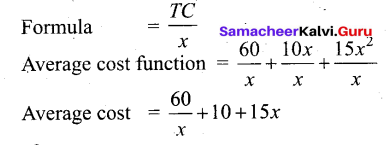
![]()
Question 29.
Give the meaning of non- renewable energy.
Answer:
Non-renewable energy sources :
- The sources of energy which cannot be renewed or re-used are called non-renewable energy sources.
- Basically these are the energy sources which will get exhausted over a period of time.
- Some of the examples of this kind of resources are coal, oil, gas etc.
Question 30.
Point out any one feature of Indian Economy.
Answer:
India has a mixed economy:
- Indian economy is a typical example of mixed economy.
- This means both private and public sector co-exist and function smoothly.
- The fundamental and heavy industrial units are being operated under the public sector, while, due to the liberalization of the economy, the private sector has gained importance.
- This markets it a perfect model for public-private partnership.
Part – III
Answer any seven question in which Question No. 40 is compulsory. [7 × 3 = 21]
Question 31.
Define Economic Development.
Answer:
- The economic development is indicated not just by GDP, but by an increase in citizen’s quality of life or well being. .
- The quality of life is being assessed by several indices such as Human Developments Index [HDI]
- On the basis of the level of economic development, nations are classified as developed and developing economies.
- Developed economies are those countries which are industrialized.
- Developments economics are also termed as advanced countries.
- On the other hand, countries which have not fully utilized their resources like land, mines, workers, etc. and have low per capita income are termed as under developed economics.
Question 32.
Specify the nature of entry of competitors in perfect competition and monopoly?
Answer:
Nature of entry of competitors in perfect competition:
- Large number of Buyers and sellers.
- Homogeneous product and uniform price.
- Free entry and exit.
- Absence of Transport cost.
- Perfect Mobility of factors of production.
- Perfect knowledge of the Market.
- No Government Intervention.
Nature of entry of competitors in Monopoly:
- There is a single producer / seller of a product.
- The product of a monopolist is unique and has no close substitute.
- There is strict barrier for entry of any new firm.
- The monopolist is a price-maker.
- The monopolist earns maximum profit / abnormal profit.
![]()
Question 33.
What are the steps involved in executing a MS Excel Sheet?
Answer:
- MS – excel is used in data analysis by using formula.
- A spread sheet is a large sheet of paper which contains rows and columns.
- The intersection of rows and columns is termed as cell.
- MS – Excel 2007 version supports up to 1 million rows and 16 thousand columns per work sheet.
MS Excel Start From Various Options:
- Click Start → Program → Micro Soft Excel
- Double click the MS Excel Icon from the Desktop
Worksheet:
MS – Excel work sheet is a table like document containing rows and columns with data
and formula
There are four kinds of calculation operators. They are:
- Arithmetic
- Comparison
- Text Concatenation [link together]
- Reference
MS – Excel helps to do data analysis and data presentation in the form of graphs, diagrams, area chart, line chart etc.
Question 34.
Differentiate between firm and Industry.
Firm
A firm refers to a single production unit in an industry, producing a large or a small quantum of a commodity or service, and selling it at a price in the market.
Its main objective is to earn a profit. There may be other objectives as described by managerial and behavioral theories of the firm.
Industry :
An industry refers to a group of firms producing the same product or service in an economy. For example: A group of firms producing cement is called a cement industry.
Question 35.
What are the measures taken towards Globalization?
Answer:
- As globalization measures tend to integrate all economies of the world and bringing them all under one umbrella.
- They pave the way for redistribution of economic power at the world level.
- Well-developed countries are favoured in this process and the welfare of the less- developed countries will be neglected.
- Globalization refers to the integration of the domestic (Indian) economy with the rest of the world.
- Import liberalization through reduction of tariff and non-tariff barriers, opening the doors to Foreign Direct Investment (FDI) and Foreign Portfolio Investment (FPI) are some of the measures towards globalization.
![]()
Question 36.
Describe the development of textile Industry in Tamil Nadu.
Answer:
- Tamil Ncidu is the largest textile hub of India.
- Tamil Nadu is known as the “Yam Bowl” of the country accounting for 41% of India’s cotton yam production.
- The textile industry plays a significant role in the Indian economy by providing direct employment to an estimated 35.million people, and thereby coiitributing 4% of GDP and 35% of gross export earnings.
- The textile sector contributes to 14% of the manufacturing sector.
- From spinning to garment manufacturing, entire textile production chain facilities are in Tamil Nadu.
- About half of India’s total spinning mill capacity is. in Tamil Nadu.
- The western part of Tamil Nadu comprising Coimbatore, Tirupur, Erode, Dindigul and Karur has the majority of spinning mills manufacturing cotton, polyester, blended yam and silk yam used by garment units in Tamil Nadu, Maharastra etc.,
- Yam is also exported to China, Bangladesh, etc.,
- Tirupur known as “knitting city” is the exporter of garments worth USD (United States Dollar) 3 billion.
- Karur is the major home for textile manufacturing (curtain cloth, bed linens, kitchen linens, toilet linens, table linens, wall hangings etc.,) and export hub in India.
- Erode is the main cloth market in South India for both retail and wholesale ready-mades.
Question 37.
The Handicrafts declined in India in British Period. Why?
Answer:
- The Indian handicrafts products had a worldwide market. ,
- Indian exports consisted chiefly of hand weaved cotton and silk fabrics, calicoes, artistic wares, wood carving etc.
- Through discriminatory tariff policy, the British Government purposefully destroyed the handicrafts.
- With the disappearance of Nawabs and Kings. There was no one to protect Indian handicrafts.
- Indian handicraft products could not complete with machine – made products.
- The introduction of railways in India increased the domestic market for the British goods.
Question 38.
What are the renewable sources of power in Tamil Nadu?
Answer:
Energy:
- Tamil Nadu tops in power generation among the southern States as seen in following table.
- Installed capacity of power utilities in States in southern region.
- Tamil Nadu is in the forefront of all other Indian States in installed capacity.
- Muppandal wind farm is a renewable energy source, supplying the villagers with electricity for work.
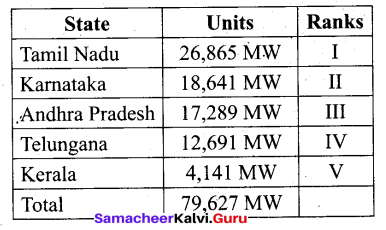
- Wind farms were built in Nagercoil and Tuticorin apart from already existing ones around Coimbatore, Pollachi, Dharapuram and Udumalaipettai.
- These areas generate about half of India’s 2,000 megawatts of wind energy or two percent of the total power output of India.
Thermal Power:
- In Tamil Nadu the share of thermal power in total energy sources is very high and the thermal power plants are at Athippattu [North Chennai] Ennore, Mettur, Neyveli and Thoothukudi.
- The generation of power under various sources is given below.
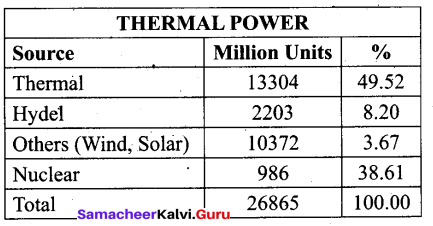
Hydel Energy:
- There are about 20 hydro-electric units in Tamil Nadu.
- The prominent units are Hundah, Mettur, Periyar, Maravakandy, Parson Valley etc.
Solar Energy:
Tamil Nadu tops in solar power generation in India as seen in following table:

Southern Tamil Nadu is considered as one of the most suitable regions in the country for developing solar power projects.
Wind Energy:
- Tamil Nadu has the highest installed wind energy capacity in India.
- The State has very high quality of offshore wind energy potential off the Tirunelveli coast and southern Thoothukudi and Rameswaram coast.
![]()
Question 39.
State any two causes of housing problem in rural areas.
Answer:
- House is one of the basic needs of every family. Provision of better housing facilities increases the productivity of labour. The housing problem is getting aggravated due to rapid adaptation of nuclear families.
- Housing does not mean provision of house alone but also proper water supply, good sanitation, proper disposal of sewage etc.
Question 40.
Describe the features of human wants.
Answer:
- Wants are unlimited: Human wants are countless in number and various in kinds. When one want is satisfied another want crops up. Human wants multiply with the growth of civilization and development.
- Wants become habits: Wants become habits; for example, when a man starts .reading news paper in the morning, it becomes a habit. Same is the case with drinking tea or chewing pans.
- Wants are Satiable: Though we cannot satisfy all our wants, at the same time we can
satisfy particular wants at a given time. When one feels hungry, he takes food and that want is satisfied. . - Wants are Alternative: There are alternative ways to satisfy a particular want eg. Idly, dosa or chappathi.
- Wants are Competitive: All our wants are not equally important. So, there is competition among wants. Hence, we have to choose more urgent wants than less urgent wants.
- Wants are Complementary: Sometimes, satisfaction of a particular want requires the use of more than one commodity. Example: Car and Petrol, Ink and Pen.
- Wants are Recurring: Some wants occur again and again. For example, if we feel hungry, we take food and satisfy our want. But after sometime, we again feel hungry and want food.
Part – IV
Answer all the questions. [7 × 5 = 35]
Question 41.
(a) Illustrate the Ricardian Theory of Rent.
Answer:
- The Classical theory of Rent is called “Ricardian Theory of Rent.”
- “Rent is that portion of the produce of the earth which is paid to the landlord for the use of the original and indestructible powers of the soil” – David Ricardo
Ricardian theory of rent assumes the following:
- Land differs in fertility.
- The law of diminishing returns operates in agriculture.
- Rent depends upon fertility and location of land .
- Theory assumes perfect competition.
- It is based on the assumption of long period.
- There is existence of marginal land or no – rent land.
- Land has certain “Original and indestructible powers”.
- Land is used for cultivation only.
- Most fertile lands are cultivated first.
Statement of the Theory:
There are three grades of land, namely A, B and C in that island. ‘A’ being most fertile ‘B’ less fertile and ‘C’ the least fertile. They will first cultivate all the most fertile land. The yield per acre on ‘A’ grade land is 40 bags of paddy. The same amount labour and capital employed in ‘A’ grade land. The yield per acre on ‘B’ grade land is 30 bags of paddy.
The Surplus of 10 bags [ 40-30] per acre appears on ‘A’ grade land. This is “ Economic Rent” land of ‘A’ grade land.
The yield per acre on ‘C’ grade land is 20 bags of paddy. This surplus of ‘A’ grade land is now raised to 20 bags [40-20] and it is the “ Economic Rent” of ‘A’ grade land.
The ‘C’ grade land cost of production is just equal to the price of its produce and therefore does not yield any rent [20-20]. Hence ‘C’ grade land is called ‘No – Rent land or marginal . land ’. The land which yields rent is called Ricardian Theory of Rent “intra-marginal land”.

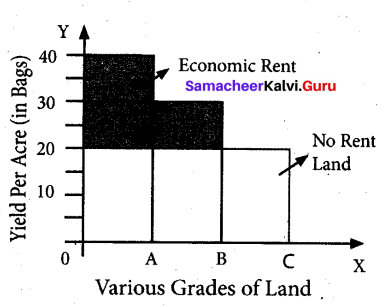
Diagrammatic Explahation:
- In diagram, X- axis represents various grades of land and Y axis represents yield per acre [in bags].
- OA, AB and BC are the ‘A’ grade ‘B’ grade and ‘C’ grade lands respectively.
- The ‘C’ grade land is the no – rent land.”
- ‘A’ land ‘B’ grade lands are “intra – marginal lands”.
- The economic rent yielded by ‘A’ and ‘B’ grade lands is equal to the shaded area of their respective rectangles.
[OR]
(b) Write the important mineral resources in India.
Answer:
Important Mineral Resources:
(i) Iron -ore:
- India possesses high quality iron -ore in abundance.
- The total reserves of iron-ore in the country are about 14.630 million tonnes of haematite and 10,619 million tonnes of magnetite.
- Hematite iron is mainly found is Chattisgarh, Jharkhand, Odisha , Goa and Karnataka.
- Some deposits of iron ore are also found in Kerala, Tamilnadu and Andra Pradesh.
(ii) Coal and Lignite:
- Coal is the largest available mineral resource.
- India ranks third in the world after China and USA in coal production
- The main centres of coal in India are the West Bengal, Bihar, Madhya. Pradesh, Maharashtra, Odisha and Andhra Pradesh.
- Bulk of the coal production comes from Bengal-Jharkhand coalfields.
(iii) Bauxite:
- Bauxite is a main source of metal like aluminium.
- Major reserves are concentrated in the East Coast bauxite deposits of Odisha and Andhra Pradesh.
(iv) Mica:
- Mica is a heat resisting mineral which is also a bad conductor of electricity.
- It is used in electrical equipments as an insulator. ‘
- India stands first in sheet mica production and contributes 60% of mica trade in the world.
- The important mica bearing pegmatite is found in Andhra Pradesh, Jharkhand, Bihar and Rajasthan.
(v) Curde Oil:
- Oil is being explored in India at many place of Assam and Gujarat.
- Digboi, Badarpur, Naharkatia, Kasimpur, Palliaria, Rudrapur, Shivsagar, Mourn [All in Assam] and Hay of Khambhat, Ankaleshwar and Kalor [All in Gujarat] are the important places of oil exploration in India.
(vi) Gold:
- India possesses only a limited gold reserve.
- There are only three main gold mine regions Kolar Goldfield, Kolar district and Hutti goldfield in Raichur district [both in Karnataka] and Ramgiri Goldfield in Anantpur district [Andhra Pradesh]
(vii) Diamond:
- The total reserves of diamond is estimated at around 4582, thousand carats which are mostly available in Panna [Madhya Pradesh], Rammallakota of Kumur district of Andhra Pradesh and also in the basin of Krishna River.
- The new Kimberlile fields have been discovered in Raipur and Pastar districts of Chhattisgarh, Nuapada and Bargarh districts of Odisha, Narayanpet-Maddur Krishna areas of Andhra Pradesh and Raichur-Gulbarga districts of Karnataka.
![]()
Question 42.
(a) What are basic economics problems?
Answer:
Basic economics problems:
- If resources are abundant and wants are so few, then there would be no economic problem.
- But this situation can never exist.
- Resources are always scarce and our wants are numerous.
Hence in every society certain choices have to be made.
The Economic Problem :
- Wants, desires; unlimited
- Resources: Scarce – Not freely available
- Economic choice
- Economics – How people use scarce resources to satisfy unlimited wants.
What and how much to produce?
Every society must decide on what goods it will produce and how much of these it will produce.
In this process, the crucial decisions include:
- Whether to produce more of food, clothing and housing or to have more luxury goods.
- Whether to have more agricultural goods or to have industrial goods and services.
- Whether to use more resources in military services.
- Whether to have more consumption goods or to have investment goods.
- Whether to spend more on basic education or higher education.
How to produce?
Every society has to decide whether it will use labour – intensive technology on capital intensive technology; that is whether to use more labour and less more machines and vice versa.
For whom to produce?
- Every society must also decide how its produce be distributed among the different sections of the society.
- It must also decide who gets more and who gets less?
- It should also decide whether or not a minimum amount of consumption be ensured for everyone in the society.
- Due to the scarcity of resources, a society faces the compulsion of making choice among alternatives.
- It face the problem of allocating the scare resources to the production of different possible goods and services and of distributing the produced goods and services among individuals within the economy.
[OR]
(b) List out the properties of iso-quants with the help of diagrams.
Answer:
Properties of Iso-quant Curve:
1. The iso-quant curve has negative slope.
It slopes downwards from left to right indicating that the factors are substitutable. If more of one factor is used, less of the other factor is needed for producing the same level of output. In the diagram combination A refers to more of capital K5 and less of labour L2. As the producer moves to B, C, and D, more labour and less capital are used.
2. Convex to the origin.
This explains the concept of diminishing Marginal Rate of Technical Substitution (MRTSlk). For example, the capital substituted by 1 unit of labour goes on decreasing when moved from top to bottom. If so, it is called diminishing MRTS. Constant MRTS (straight line) and increasing MRTS (concave) are also possible. It depends on the nature of iso-quant curve.
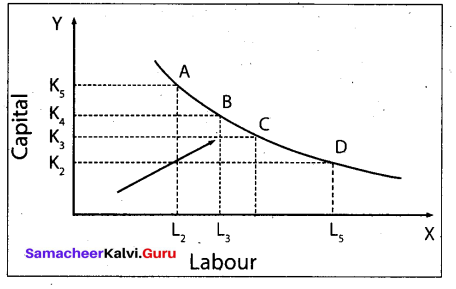
This means that factors of production are substitutable to each other. The capital substituted per unit of labour goes on decreasing when the iso-quant is convex to the origin.
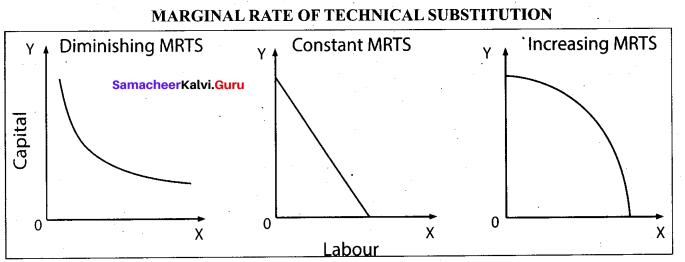
3. Non inter-section of Iso-quant curves.
For instance, point A lie on the isoquants IQ1 and IQ2 But the point C shows a higher output and the point B shows a lower level of output IQ1 If C = A, B = A, then C = B. But C > B which is illogical.
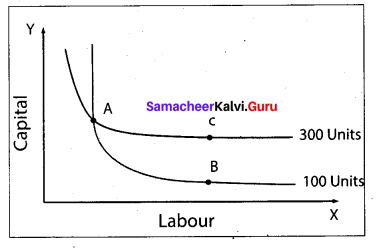
4. An upper iso-quant curve represents a higher level of output.
Higher IQS show higher outputs and lower IQs show lower outputs, for upper iso-quant curve implies the use of more factors than the lower isoquant curve. ‘
The arrow in the figure shows an increase in the output with a right and upward shift of an iso-quant curve.
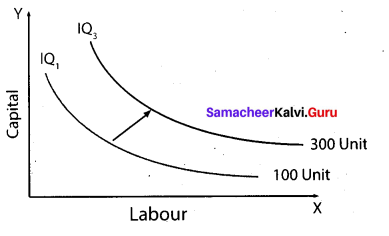
5. Iso-quant curve does not touch either X axis or Y axis.
No iso-quant curve touches the X axis or Y axis because in IQ1 only capital is used, and in IQ2 only labour is used.
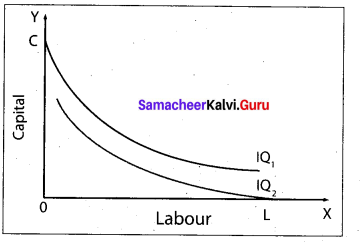
![]()
Question 43.
(a) Bring out features of perfect competition.
Answer:
Features of the perfect competition:
(0 Large Number of Buyers and sellers
- “A large number of buyers” implies that each individual buyer buys a very very small quantum of a product as compared to that found in the market.
- This means that he has no power to fix the price of the product.
- He is only a price-taker and not a price-maker ‘
- Large number of sellers” implies that share of each individual seller is a very very small quantum of a product.
- No power to fix the price of the product.
(ii) Homogeneous Product and Uniform Price
- The product sold and bought is homogeneous in nature, in the sense that the units of the product are perfectly substitutable.
- All the units of the product are identical i.e., of the same size, shape, colour, quality etc.
- Therefore, a uniform price prevails in the market.
(iii) Free Entry and Exit
- In the short run, it is possible for the very efficient producer, producing the product at a very low cost, to earn super normal profits.
- An inefficient producer, who is unable to bring down the cost incurs loss.
(iv) Absence of Transport Cost
The prevalence of the uniform price is also due to the absence of the transport cost.
(v) Perfect Mobility of Factors of Production
- The prevalence of the uniform price is also due to the perfect mobility of the factors of production.
- As they enjoy perfect freedom to move from one place to another and from one occupation to another, the price gets adjusted.
(vi) Perfect Knowledge of the Market
All buyers and sellers have a thorough knowledge of the quality of the product, prevailing price etc.
(vii) No Government Intervention
There is no government regulation on supply of raw materials, and in the determination of price etc.
[OR]
(b) Explain the Marginal productivity theory of distribution.
Answer:
Introduction:
- This theory was developed by Clark, Wickseed and Walras . The Marginal productivity theory of Distribution explains how the prices of various factors of production are determined.
- This theory explains how rent, wages, Interest and profit are determined.
- This theory is also known as “ General Theory of Distribution ” or “ National Dividend Theory of Distribution”.
Assumptions:
- All the factors of production are homogenous.
- Factors of production can be substituted for each other.
- There is perfect competition both in the factor market and product market.
- There is perfect mobility of factors of production.
- There is full employment of factors.
- This theory is applicable only in the long – run.
- The entrepreneurs aim at profit maximization!
- There is no government intervention in fixing the price of a factor.
- There is no technological change. ,
Explanation of the theory:
According to the Marginal Productivity Theory of Distribution, the price or the reward for any factor of production is equal to the marginal productivity of that factor. Each factor is rewarded according to its marginal productivity.
Marginal Product:
The Marginal Product is also known as “ Marginal Physical Product “ [MPP]. The Marginal Product of a factor of production means the addition made to total product by employment of an additional unit of that factor. The Marginal Product may be expressed as MPP, VMP and MRP.
- Marginal Physical product [MPP]: The Marginal Physical Product of a factor is the increment in the total product obtained by the employment of an additional unit of that factor.
- Value of a marginal product [VMP]: The Value of Marginal Product is obtained by multiplying the marginal physical product of the factor by the price of product. Symbolically VMP = MPP x Price
- Marginal Revenue product : [MRP]: The Marginal Revenue Product of a factor is the increment in the total revenue which is obtained by the employment of an additional unit of that factor.
MRP = MPP x MR
The Marginal Productivity Theory of Distribution states that
- The price of a factor of production depends upon its productivity.
- The price of a factor is determined by and will be equal to marginal revenue product of that factor.
- Under certain conditions the price of a factor will be equal to both the average and marginal products of that factor.
![]()
Question 44.
(a) Analyse the causes for Rural Indebtedness.
Answer:
The Causes for Rural Indebtedness:
(i) Poverty of Farmers:
- The vicious circle of poverty forces the farmers to borrow for consumption and cultivation.
- Thus poverty, debt and high rates of interest hold the farmer in the grip of money lenders.
(ii) Failure of Monsoon:
- Frequent failure of monsoon is a curse to the farmers and they have to suffer due to the failure of nature.
- Farmers find it difficult to identify good years to repay their debts. ‘
(iii) Litigation:
- Due to land disputes litigation in the court compels them to borrow heavily.
- Being uneducated and ignorant they are caught in the litigation process and dry away their savings and resources.
(iv) Money Lenders and High Rate of Interest:
The rate of interest charged by the local money lenders is very high and the compounding
of interest leads to perpetuate indebtedness of the farmer.
[OR]
(b) Explain shift in the demand curve.
Answer:
A shift in the demand curve occurs with a change in the value of a variable other than its price in the general demand function. An increase or decrease in demand due to changes in conditions of demand is shown by way of shifts in the demand curve.
On the left hand side of the diagram, the original demand curve is dd, the price is OP, and the quantity demanded is P3. Due to change in the conditions of demand (change in income, taste or change in prices of substitutes and /or complements) the quantity . demanded decreases from OQ1 to OQ2. This is shown in the demand curve to the left side new demand curve is d1d1,. This is called decrease in demand.
On the right hand side of the diagram, the original price is OP1 and the quantity demanded is OQ1 . Due to changes in other conditions, the quantity purchased has increased to OQ2 Thus the demand curve shifts to the right d1d1. This is called increase in demand.
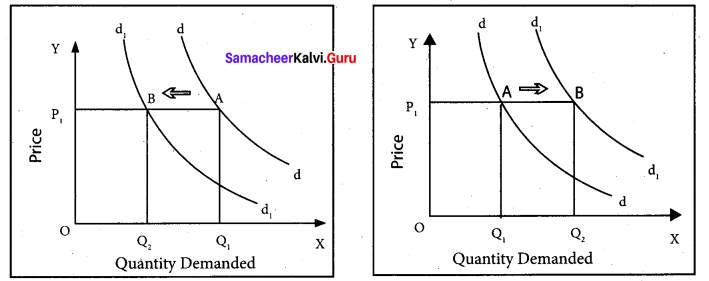
‘Extension’ and ‘Contraction’ of demand follow a change in price. Increases and decreases in demand take place when price remains the same and the other factors bring about demand changes.
![]()
Question 45.
(a) What is Duopoly and characteristics of Duopoly?
Answer:
Duopoly is a special case of the theory of oligopoly in which there are only two sellers. Both the sellers are completely independent and no agreement exists between them. Even though they are independent, a change in the price and output of one will affect the other, and may set a chain of reactions. A seller may, however, assume that his rival is unaffected by what he does, in that case he takes only his own direct influence on the price.
Characteristics of Duopoly:
- Each seller is fully aware of his rival’s motive and actions.
- Both sellers may collude (they agree on all matters regarding the sale of the commodity).
- They may enter into cut-throat competition.
- There is no product differentiation. .
- They fix the price for their product with a view to maximising their profit.
[OR]
(b) Explain the Marginal Productivity Theory of Distribution.
Answer:
Introduction:
- This theory was developed by Clark, Wickseed and Walras. The Marginal productivity theory of Distribution explains how the prices of various factors of production are determined.
- This theory explains how rent, wages, Interest and profit are determined.
- This theory is also known as “General Theory of Distribution” or “National Dividend Theory of Distribution”.
Assumptions:
- All the factors of production are homogenous.
- Factors of production can be substituted for each other.
- There is perfect competition both in the factor market and product market.
- There is perfect mobility of factors of production.
- There is full employment of factors.
- This theory is applicable only in the long – run.
- The entrepreneurs aim at profit maximization.
- There is no government intervention in fixing the price of a factor.
- There is no technological change.
Explanation of the theory:
According to the Marginal Productivity Theory of Distribution, the price or the reward for any factor of production is equal to the marginal productivity of that factor. Each factor is rewarded according to its marginal productivity.
Marginal Product:
The Marginal Product is also known as “ Marginal Physical Product “ [MPPJ. The Marginal Product of a factor Of production means the addition made to total product by employment of an additional unit of that factor. The Marginal Product may be expressed as MPP, VMP and MRP.
- Marginal Physical Product [MPP]: The Marginal Physical Product of a factor is the increment in the total product obtained by the employment of an additional unit of that factor.
- Value of a Marginal Product [VMP]: The Value of Marginal Product is obtained by multiplying the marginal physical product of the factor by the price of product. Symbolically VMP = MPP x Price
- Marginal Revenue Product: [MRP]: The Marginal Revenue Product of a factor is the increment in the total revenue which is obtained by the employment of an additional unit of that factor.
MRP = MPP x MR
The Marginal Productivity Theory of Distribution states that
- The price of a factor of production depends upon its productivity.
- The price of a factor is determined by and will be equal to marginal revenue product of that factor.
- Under certain conditions the price of a factor will be equal to both the average and marginal products of that factor.
Question 46.
(a) Explain the objectives and characteristics of SEZs.
Answer:
- The Special Economic Zones [SEZs] Policy was announced in April 2000.
- The Special Economic Zones Act of 2005, the government has so far notified about 400 such zones in the country.
Major objectives of SEZs:
- To enhance foreign investment, especially to attract foreign direct investment [FDI] and thereby increasing GDP.
- To increase shares in Global Export. (International Business)
- To generate additional economic activity.
- To create employment opportunities.
- To develop infrastructure facilities.
- To exchange technology in the global market.
Main Characteristics of SEZ:
- Geographically demarked area with physical security.
- Administrated by single body authority.
- Streamlined procedures.
- Having separate custom area.
- Governed by more liberal economic laws.
- Greater freedom to the firms located in SEZs.
[OR]
(b) Describe the qualitative aspects of population.
Answer:
Tamil Nadu stands sixth in population with 7.21 crore against India’s 121 crore as per 2011 censes. Tamil Nadu’s population is higher than that of several countries according to UN report. Tamil Nadu population 7.2 [crores] in 2017.
Density:
- The density of population which measures population per sq.km is 555 [2011] against 480 [2001],
- Tamil Nadu ranks 12th in density among the Indian States and overall it is 382 for India.
Urbanisation:
- Tamil Nadu is the most urbanized state with 48.4% of urban population against 31.5% for • India as a whole.
- The State accounts for 9.61% of total urbanites irt India against 6% share of total population.
- Sex Ratio [Numbers of female per 1000 males],
- Balanced sex ratio implies improvement in quality of life of female population.
- The sex ratio in Tamil Nadu is nearing balance with 995 which is far better compared to most of the states and all India level.
- Tamil Nadu stands third next only to Kerala State and Puducherry Union Territory in sex ratio.
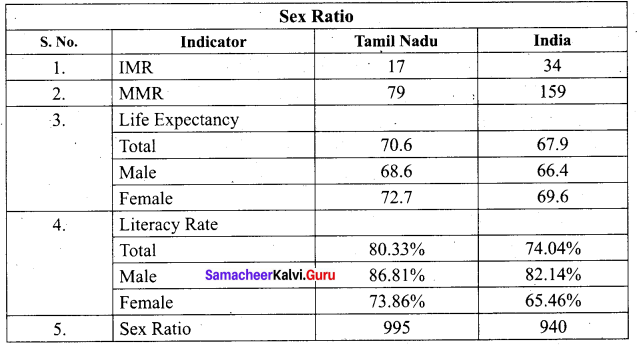
![]()
Question 47.
(a) Explain basic problems of the economy with the help of production possibility curve.
Answer:
The problem of choice between relatively scarce commodities due to limited productive resources with the society can be illustrated with the help of a geometric device, is known as production possibility curve. Production possibility curve shows the menu of choice
along which a society can choose to substitute one good for another, assuming a given state of technology and given total resources.
The explanation arid analysis of production possibility curve is based upon certain assumptions, some of them are following:
- The time period does not change. It remains the same throughout the curve.
- Techniques of production are fixed.
- There is full employment in the economy.
- Only two goods can be produced from the given resources.
- Resources of production are fully mobile.
- The factors of production are given in quantity and quality.
- The low of diminishing returns operates in production.
Every production possibility curve is based upon these assumptions. If some of these assumptions changes or negelected, then it affects the nature of production possibility curve.
To draw this curve we take the help of production possibilities schedule, as shown below.
Production possibilities schedule
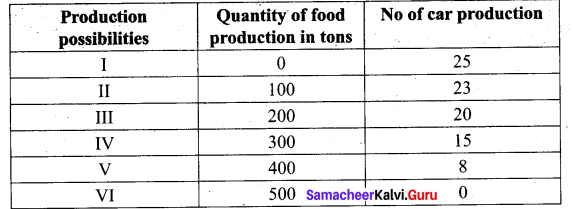
The schedule suggests that if all resources are thrown into the production of food, a maximum of 500 tons of food can be produced, given the existing technology. If on the other hand, all resources are instead used for producing cars, 25 cars can be produced. In between these two extreme possibilities exist. If we are willing to give up some food, we can have some cars.
We can obtain a production possibility curve by drawing production possibilities schedule graphically. The quantity of food is shown on x-axis and the number of cars is shown on y-axis, the different six production possibilities are being shown as point P1 P2 P3 P4 P5 & P6
Problems of the economy
1. The problem of choice:
The problem of choice arise because of the given limited resources and unlimited wants, may relate to the allocation of resources between the goods for the higher income group and the lower income group and the goods for the defense and the civilians. Since PPC is the locus of the combination of the goods the problem of choice will not arises when we choose any point on PPC.
2. Solution of central problems:
The central problems of an economy can be explained with the help of PPC. The solution of problem of what to produce involves the decision regarding the choice of location on the production possibility carves. A production combination represented by any point inside the PPC indicates that the economy is using inefficient methods of production and inefficient combination of resources.
![]()
[OR]
(b) What are the properties of indifference curve?
Answer:
Indifference curves are subjective and unique to each person nevertheless they have in common the following properties:
1. Indifference curve must have negative slope:
An indifference curve has a negative slope, which denotes that if the quantity of ‘ commodity (y) decreases, the quantity of the other (x) must increase, if the consumer is to stay on the same level of satisfaction.
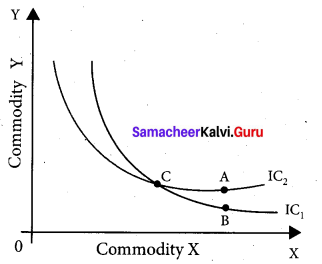
2. Indifference curves are convex to the origin:
Indifference curves are not only negatively sloped, but are also convex to the origin.
The convexity of the indifference curves implies that not only two commodities are substitutes for each other but also the fact that the marginal rate of substitution (MRS) between the goods decreases as a consumer moves along an indifference curve.
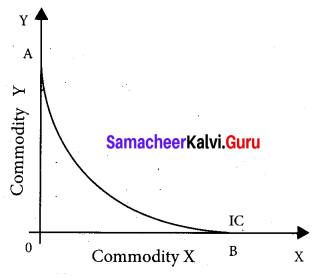
3. Indifference curve cannot intersect:
IC1 is lower indifference curve denoting lesser satisfaction. Combination C and B fall on IC1
IC2 is upper indifference curve denoting higher satisfaction. C and A combinations are on IC2
At the point of intersection, C = B on IC1 and C = A on IC2. So A = B whereas, A is in upper IC and B is on lower IC.
This is not possible.
4. Indifference curves do not touch the horizontal or vertical axis.
If they touch the axis, it violates the basic assumption that the consumer purchases two commodities in a combination.